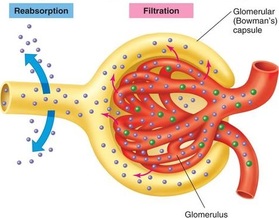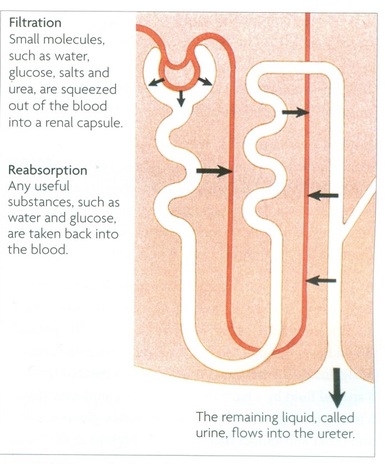# 91 Function of the kidney - filtration and reabsorption
The function of the kidney is to filter blood, removing urea and excess H2O, reabsorbing glucose, some H2O and some mineral salts.
Urine is made by filtration and selective reabsorption
- As blood passes through the kidneys, it is filtered. This removes most of the urea from it, and also excess H2O and salts.
- As this liquid moves through the kidneys, any glucose in it is reabsorbed back into the blood. Most of the H2O is also reabsorbed along with some of the salts.
The final liquid produced by the kidneys is a solution of urea and salts in water. It is called urine, and it flows out of the kidneys, along the ureters and into the bladder. It is stored in the bladder for a while, before being released from the body through the urethra.
Filtration happens in renal capsules
Blood is brought to the renal capsule in a branch of the renal artery. Small molecules, including water and most of the things dissolved in its, are squeezed out of the blood into the renal capsule.
There are thousands of renal capsules in the cortex of each kidney. Each one is shaped like a cup. It has a tangle of blood capillaries, called a glomerulus, in the middle. The blood vessels bringing blood to each glomerulus is quite wide, but the one taking blood away is narrow. This means that the blood in the glomerulus cannot get away easily. Quite a high pressure builds up, squeezing the blood in the glomerulus against the capillary walls.
These walls have small holes in them. So do the walls of the renal capsules. Any molecules small enough to go through these holes will be squeezed through, into the space in the renal capsule.
Only small molecules can go through. These include water, salt, glucose and urea. Most protein molecules are too big, so they stay in the blood, along with the blood cells.
Filtration happens in renal capsules
Blood is brought to the renal capsule in a branch of the renal artery. Small molecules, including water and most of the things dissolved in its, are squeezed out of the blood into the renal capsule.
There are thousands of renal capsules in the cortex of each kidney. Each one is shaped like a cup. It has a tangle of blood capillaries, called a glomerulus, in the middle. The blood vessels bringing blood to each glomerulus is quite wide, but the one taking blood away is narrow. This means that the blood in the glomerulus cannot get away easily. Quite a high pressure builds up, squeezing the blood in the glomerulus against the capillary walls.
These walls have small holes in them. So do the walls of the renal capsules. Any molecules small enough to go through these holes will be squeezed through, into the space in the renal capsule.
Only small molecules can go through. These include water, salt, glucose and urea. Most protein molecules are too big, so they stay in the blood, along with the blood cells.
Useful substances are reabsorbed
The fluid in the renal capsule is a solution of glucose, salts and urea dissolved in water. Some of the substances in this fluid are needed by the body. All of the glucose, some of the water ans some of the salts need to be kept in the blood.
Wrapped around each kidney tubule are blood capillaries. Useful substances from the fluid in the kidney tubule are reabsorbed, and pass back into the blood in these capillaries.
The remaining fluid continues on its way along the tubule. By the time it gets to the collecting duct, it is mostly water, with urea and salts dissolved in its. It is called urine. The kidneys are extremely efficient at reabsorbing water. Over 99% of the water entering the tubules is reabsorbed.
The relative amount of water reabsorbed depends on the state of hydration of the body (how much water is in the blood), and is controlled by secretion of the hormone ADH.
Video: Nephron function
The fluid in the renal capsule is a solution of glucose, salts and urea dissolved in water. Some of the substances in this fluid are needed by the body. All of the glucose, some of the water ans some of the salts need to be kept in the blood.
Wrapped around each kidney tubule are blood capillaries. Useful substances from the fluid in the kidney tubule are reabsorbed, and pass back into the blood in these capillaries.
The remaining fluid continues on its way along the tubule. By the time it gets to the collecting duct, it is mostly water, with urea and salts dissolved in its. It is called urine. The kidneys are extremely efficient at reabsorbing water. Over 99% of the water entering the tubules is reabsorbed.
The relative amount of water reabsorbed depends on the state of hydration of the body (how much water is in the blood), and is controlled by secretion of the hormone ADH.
- On a hot day: we sweat more to cool down --> the body needs to conserve water --> produce a small amount of concentrated urine.
- On a cold day: little sweat is being produced --> we tend to produce a larger volume of dilute urine.
Video: Nephron function





